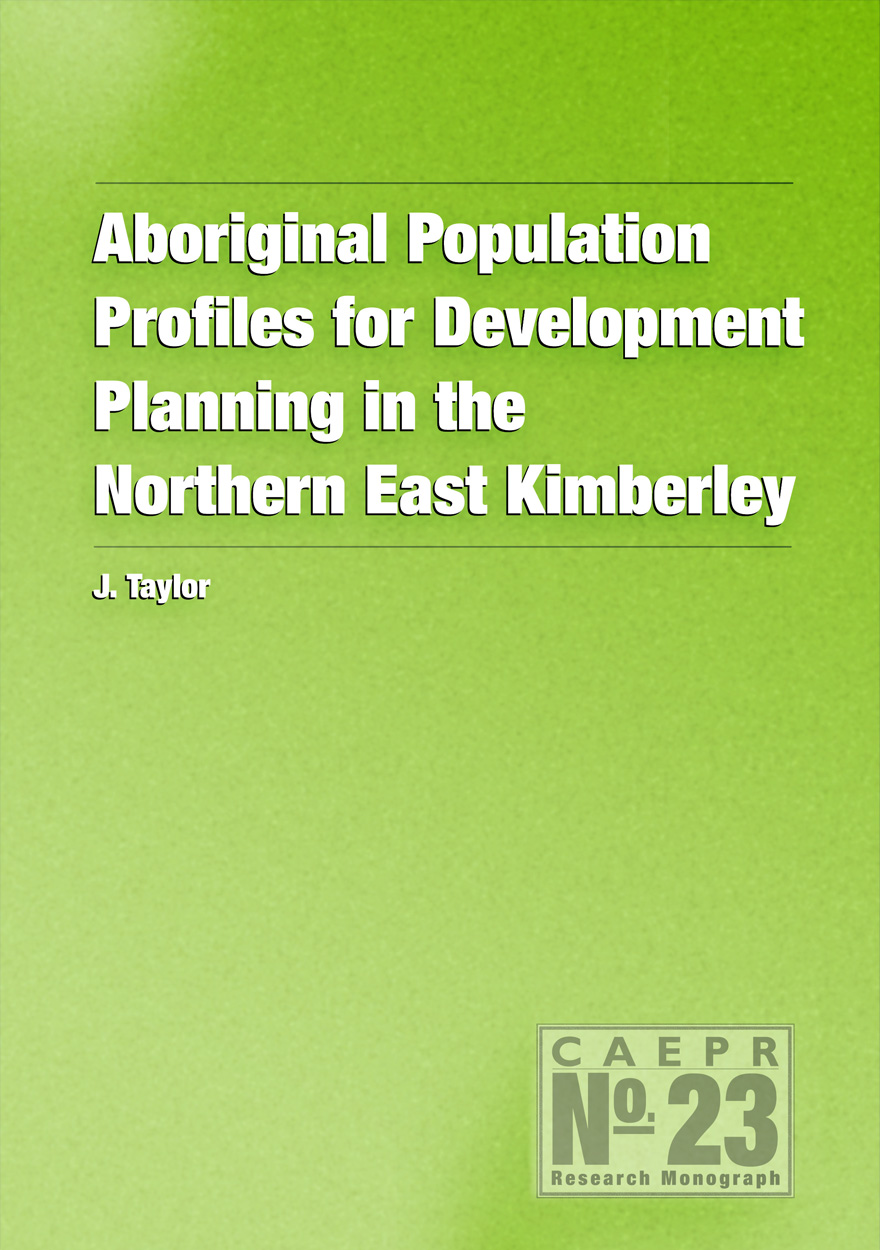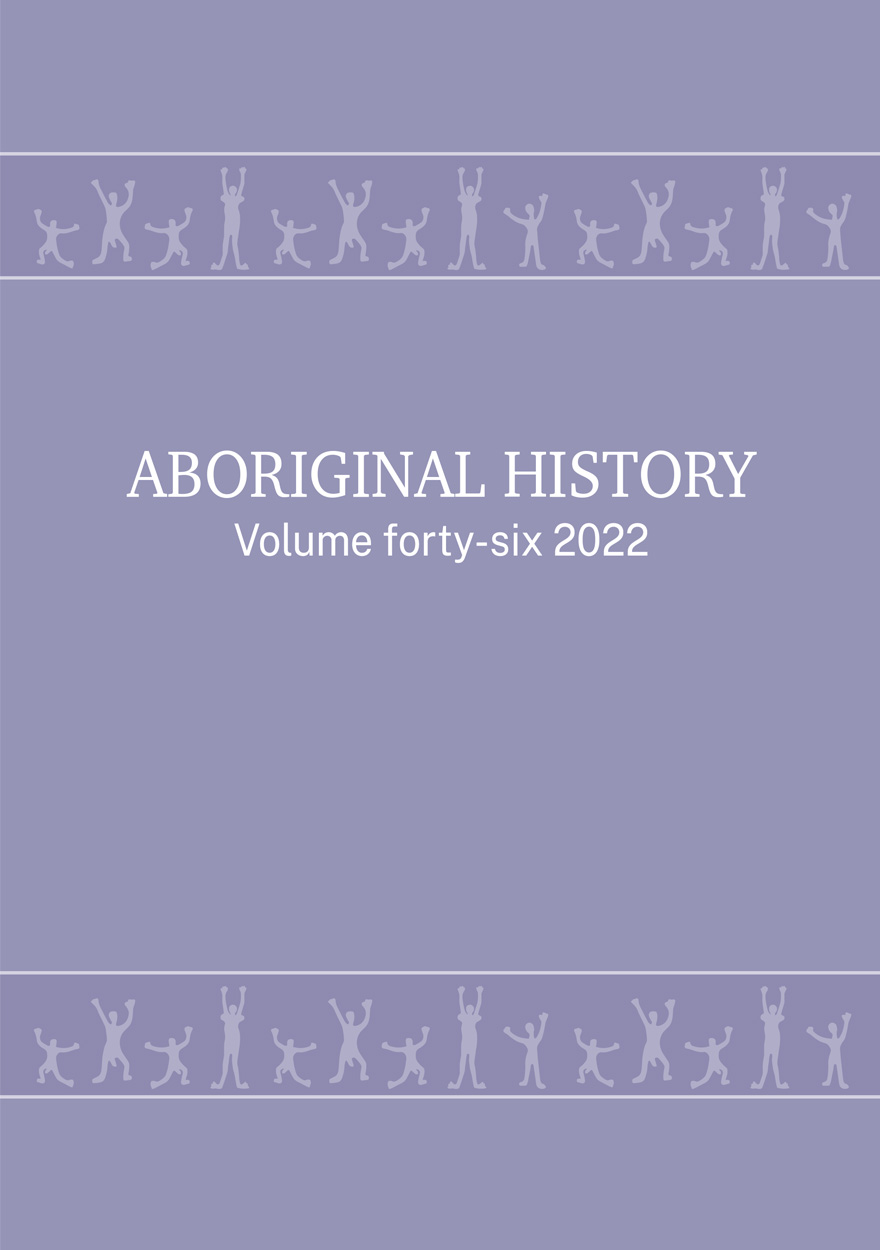Search titles
Displaying results 41 to 50 of 132.

Aboriginal History Journal: Volume 4 »
Publication date: 1980
Since 1977, the journal Aboriginal History has pioneered interdisciplinary historical studies of Australian Aboriginal people’s and Torres Strait Islander’s interactions with non-Indigenous peoples. It has promoted publication of Indigenous oral traditions, biographies, languages, archival and bibliographic guides, previously unpublished manuscript accounts, critiques of current events, and research and reviews in the fields of anthropology, archaeology, sociology, linguistics, demography, law, geography and cultural, political and economic history.
Aboriginal History Inc. is a publishing organisation based in the Australian Centre for Indigenous History, Research School of Social Sciences, The Australian National University, Canberra.
For more information on Aboriginal History Inc. please visit aboriginalhistory.org.au.
Download for free
Not available for purchase

Aboriginal History Journal: Volume 3 »
Publication date: 1979
Since 1977 the journal Aboriginal History has pioneered interdisciplinary historical studies of Australian Aboriginal people's and Torres Strait Islander's interactions with non-Indigenous peoples. It has promoted publication of Indigenous oral traditions, biographies, languages, archival and bibliographic guides, previously unpublished manuscript accounts, critiques of current events, and research and reviews in the fields of anthropology, archaeology, sociology, linguistics, demography, law, geography and cultural, political and economic history.
Aboriginal History Inc. is a publishing organisation based in the Australian Centre for Indigenous History, Research School of Social Sciences, The Australian National University, Canberra.
For more information on Aboriginal History Inc. please visit aboriginalhistory.org.au.
Download for free
Not available for purchase

Aboriginal History Journal: Volume 2 »
Publication date: 1978
Since 1977, the journal Aboriginal History has pioneered interdisciplinary historical studies of Australian Aboriginal people’s and Torres Strait Islander’s interactions with non-Indigenous peoples. It has promoted publication of Indigenous oral traditions, biographies, languages, archival and bibliographic guides, previously unpublished manuscript accounts, critiques of current events, and research and reviews in the fields of anthropology, archaeology, sociology, linguistics, demography, law, geography and cultural, political and economic history.
Aboriginal History Inc. is a publishing organisation based in the Australian Centre for Indigenous History, Research School of Social Sciences, The Australian National University, Canberra.
For more information on Aboriginal History Inc. please visit aboriginalhistory.org.au.
Download for free
Not available for purchase

Aboriginal History Journal: Volume 1 »
Publication date: 1977
Since 1977, the journal Aboriginal History has pioneered interdisciplinary historical studies of Australian Aboriginal people’s and Torres Strait Islander’s interactions with non-Indigenous peoples. It has promoted publication of Indigenous oral traditions, biographies, languages, archival and bibliographic guides, previously unpublished manuscript accounts, critiques of current events, and research and reviews in the fields of anthropology, archaeology, sociology, linguistics, demography, law, geography and cultural, political and economic history.
Aboriginal History Inc. is a publishing organisation based in the Australian Centre for Indigenous History, Research School of Social Sciences, The Australian National University, Canberra.
For more information on Aboriginal History Inc. please visit aboriginalhistory.org.au.
Download for free
Not available for purchase

Aboriginal History Journal: Volume 41 »
Edited by: Ingereth Macfarlane, Liz Conor
Publication date: December 2017
The articles in Volume 41 bring to light historical sources from the colonial frontier in Tasmania (Nicholas Brodie and Kristyn Harman) and South Australia (Skye Kirchauff) to provoke reassessments of colonial attitudes and expectations. Karen Hughes brings into focus little-known, intimate aspects of Indigenous women’s experience with African American servicemen on the World War II Australian home front. Diana Young’s study of accounts of Pitjantjatjara women’s careful productions in the Ernabella craft rooms in the mid-twentieth century deepens our understanding of a relatively neglected aspect of the art history of ‘first generation, postcontact Indigenous art-making among Australian Western Desert peoples’. Nikita Vanderbyl explores records of tourists’ visits to Aboriginal reserves in the late 1800s and early 1900s, focusing on the emotive aspects of the visits, and making the links between such tourism and colonialism. Janice Newton provides a close examination of the cross-cultural signs implicated in a documented ceremonial performance in early Port Phillip. Heather Burke, Lynley Wallis and their collaborators compare a reconstructed stone building in Richmond, Queensland, with other reputedly fortified structures, and find that the historical and structural evidence for this interpretation are equivocal, pointing to imaginaries of the violent frontier as much as tangible experience.
Aboriginal History Inc. is a publishing organisation based in the Australian Centre for Indigenous History, Research School of Social Sciences, The Australian National University, Canberra.
For more information on Aboriginal History Inc. please visit aboriginalhistory.org.au.
Download for free
Not available for purchase

Aboriginal History Journal: Volume 36 »
Edited by: Shino Konishi, Maria Nugent
Publication date: January 2013
In this volume, Bain Attwood details the personalities and the politics surrounding the foundation and early years of the Aboriginal History journal and the intellectual stakes involved in the various disputes that emerged. Attwood has drawn extensively on the journal’s archives, as well as interviewed many of the players involved. Jonathan Richards’ article explores the evacuation of the Cape Bedford mission in Queensland during the Second World War. Muriel Swijghuisen Reigersberg is an ethnomusicologist. Her article examines the contemporary uses of church music and song to tell local histories and to express belonging to place at Hopevale, Queensland. Amanda Nettelbeck and Robert Foster provide a history of rationing on the nineteenth-century settler frontiers in Australia and North West Canada, showing the value of a comparative approach. Jennifer Jones’ piece about the editing of Ella Simon’s autobiographical text, Through My Eyes, provides original insights into the complicated politics and meanings of assimilation. Anne Scrimgeour illuminates an important event in twentieth-century history, looking at the Pindan mob’s challenge to the restrictive leper line in Western Australia.
Aboriginal History Inc. is a publishing organisation based in the Australian Centre for Indigenous History, Research School of Social Sciences, The Australian National University, Canberra.
For more information on Aboriginal History Inc. please visit aboriginalhistory.org.au.
Download for free
Not available for purchase

Aboriginal Population Profiles for Development Planning in the Northern East Kimberley »
Authored by: John Taylor
Publication date: March 2004
John Taylor is a Senior Fellow at the Centre for Aboriginal Economic Policy Research, The Australian National University, Canberra.
The Northern East Kimberley region of Western Australia is poised at a development crossroads with decisions pending on the extension or closure of Argyle Diamond Mine, and the ever-present prospect of agricultural expansion based on Ord Stage II. This region also has a major economic development problem—half of its adult population (almost all Aboriginal) is highly dependent on welfare, mostly outside the mainstream labour market, and ill-equipped to engage it.
Aboriginal people are major stakeholders in the region as its customary owners and most permanent residents. Whatever decisions are made about future development, it is essential that they bring about improvements in Aboriginal participation, not least because of the high opportunity cost to Aboriginal people and to government of failing to do so.
This study profiles social and economic conditions in the region, focusing on the Aboriginal population. It examines demography, the labour market, income, education and training, housing and infrastructure, health status, and regional involvement in the criminal justice system. It provides a quantum to discussions of need, aspirations and regional development capacities, as well as a benchmark against which the impact of developmental actions may be assessed.

Aboriginal History Journal: Volume 45 »
Edited by: Crystal McKinnon, Ben Silverstein
Publication date: April 2022
This volume begins with Michael Aird, Joanna Sassoon and David Trigger’s meticulous research tracing the well-known but sometimes confused identity of Jackey Jackey of the Lower Logan River in south-east Queensland. Emma Cupitt describes the multivocality and intertextuality of Radio Redfern’s coverage of Aboriginal protests in Sydney as the 1988 Australian Bicentenary celebrations took place elsewhere in the city. Similarly approaching sources for their multiplicity, Matt Poll and Amanda Harris provide a reading of the ambassadorial work performed by assemblages of Yolngu bark paintings in diverse exhibition spaces after the Second World War.
Cara Cross historicises the production and use of mineral medicine—or lithotherapeutics—derived from Burning Mountain in Wonnarua Country, issuing a powerful call for the recognition of Indigenous innovation as cultural heritage. In a collaborative article, Fred Cahir, Ian Clark, Dan Tout, Benjamin Wilkie and Jidah Clark read colonial records against the grain to narrate a nineteenth-century history of Victorian Aboriginal relationships with fire, strengthening the case for the revitalisation of these fire management practices. And, based on extensive oral history work, Maria Panagopoulos presents Aboriginal narrations of the experience of moving—or being moved—from the Manatunga settlement on the outskirts of Robinvale into the town itself, on Tati Tati Country in the Mallee region of Victoria.
In addition to a range of book reviews, we are also pleased to include Greg Lehman’s review essay concerning Cassandra Pybus’s recent award-winning Truganini: Journey through the Apocalypse, which considers the implications of our relationships with history and how they help to think through practices of researching and writing Aboriginal history.
Download for free
Not available for purchase

Aboriginal History Journal: Volume 48 »
Edited by: Crystal McKinnon, Ben Silverstein
Publication date: 2025
In this volume, Christopher Morton carefully traces the provenance of a Wiradjuri or Gamilaroi marara (tree carving) currently resting at the Pitt Rivers Museum in Oxford, considering its unfinished journey and the way it has been framed and recontextualised, as well as the ways it may experience a future return to good relation with and in Country. Julia Mortensen draws on oral histories of life and mobility in and around the Yumba – a ‘fringe camp’ at Cunnamulla – to narrate generations of autonomy from formal state control, reconsidering the Yumba as a centre of Aboriginal action and community strength: the centre, not the fringe. And on the 35th anniversary of the publication of Henrietta Fourmile’s landmark article ‘Who Owns the Past?’, Kirsten Thorpe returns to this work, centring the archival sovereignty that Fourmile sought and towards which First Nations archivists work today. This sovereignty is reflected in the following conversation between Gundungurra woman Kazan Brown and non-Indigenous historians Emily O’Gorman and Grace Karskens, transcribed by Natalie Osborne, which represents Gundungurra Country as storied, enduring and under threat.
The volume includes two memorial sections, remembering Frances Peters-Little and Lyndall Ryan and reflecting on their vital contributions to this journal and to the wider field of Aboriginal history. Alongside several book reviews, we present a review forum responding to Shannyn Palmer’s Prime Ministers’ Literary Award-winning Unmaking Angas Downs: Myth and History on a Central Australian Pastoral Station.
Coming soon
Notify me
Aboriginal History Journal: Volume 46 »
Edited by: Crystal McKinnon, Ben Silverstein
Publication date: July 2023
The articles in Volume 46 each take provocative and generative approaches to the challenge of historical truth-telling. Examining the public memory of massacres in Gippsland, Victoria, Aunty Doris Paton, Beth Marsden and Jessica Horton trace a history of contestation between, on the one hand, forms of frontier memorialisation articulated to secure colonial possession and, on the other, the sovereign counter-narratives of Gunai Kurnai communities. Heidi Norman and Anne Maree Payne describe Aboriginal campaigns to repatriate Ancestors’ stolen remains over the past fifty years, showing how these campaigns have proceeded along with and as part of nation-building movements towards land rights and self-determination. Their call for Aboriginal relationships with Ancestors to be represented in a National Resting Place aligns their research with these movements. We return to Gunai Kurnai Country in a piece authored by Rob Hudson and Shannon Woodcock, who show how the Krowathunkooloong Keeping Place has formed an important site and tool of community work towards cultural resurgence; the article itself demonstrates the value and importance of collaborative and co-designed research methods. The volume then includes a conversation between Laura McBride and Mariko Smith about their curation of the Australian Museum’s Unsettled exhibition, through which they responded to the 250th anniversary of Cook’s Endeavour voyage along Australia’s east coast by telling true stories that put Cook in his place.



